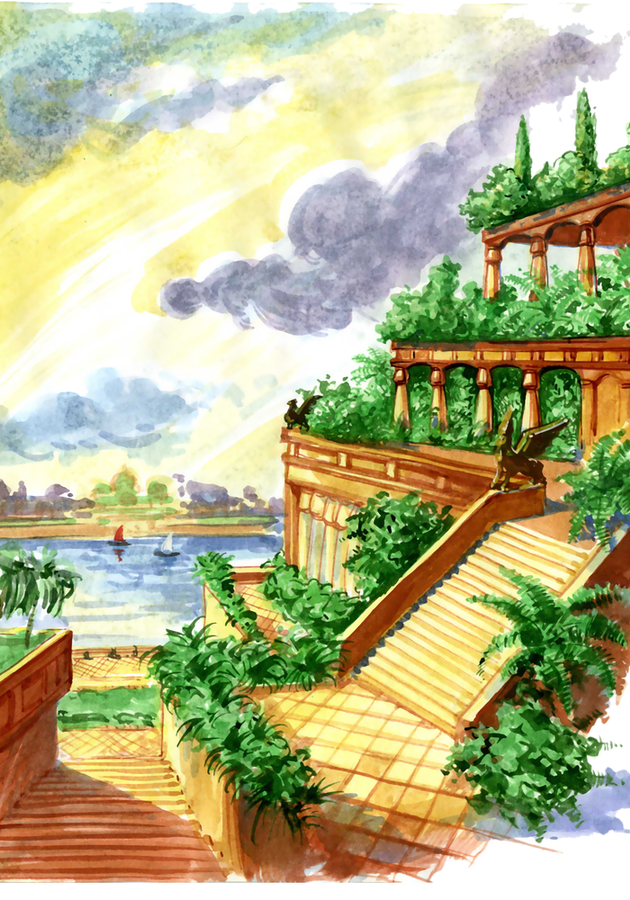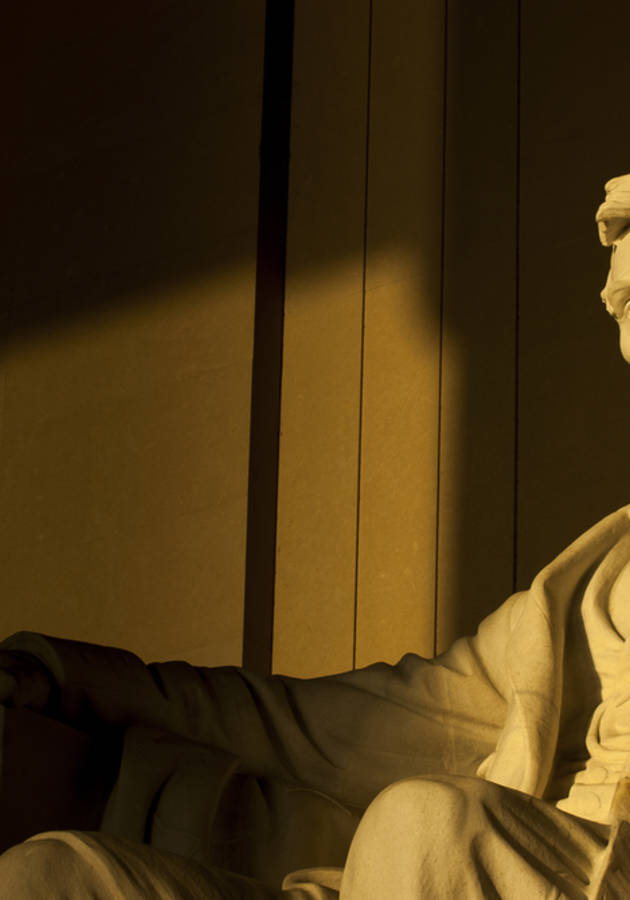The Pyramids of Giza are still standing, the only one of the Seven Wonders of the Ancient World which survives to this day in an almost complete and recognizable form. In the cases of the Temple of Artemis and the Lighthouse of Alexandria, not only have we found some substantial remains, but likewise ancient and medieval authors paint a pretty vivid and accurate picture at several different phases of their existence. The Statue of Zeus at Olympia may have disappeared for good, but we have the ruins of the temple in which it sat as well as one very detailed description by the geographer Pausanias. Finally, even though almost nothing survives of either the Mausoleum at Halicarnassus or the Colossus of Rhodes, their essential nature is clear to us from numerous ancient accounts, and both are easily apprehended as single and distinctive creations.
The luxurious Hanging Gardens of Babylon are a wholly different story. The only one of the Seven Wonders for which the location hasn’t been definitely established to this day, they seem more likely to be the stuff of legend than of fact. Indeed, they survive much more forcefully in the imagination of modern dreamers than they do in written history, however vivid the original accounts. The fact is that their existence is attested by only a small number of ancient authors, and curiously, not one of them is Babylonian. Be that as it may, Greek travelers are adamant that the Hanging Gardens were very real and, moreover, that they were an extraordinary feat of engineering, boasting an ascending series of groves, adorned with baroque fountains and suspended on interlacing arches – truly a lush paradise in the vast deserts of the Levant! But is there any truth in these descriptions? Should we believe them?
The history of Babylon
Founded in 20th century BC, Babylon was merely a small provincial town until the famous codifier Hammurabi conquered the neighboring Assyrian kingdom and gained control of the entirety of the lower Mesopotamian plain around 1760 BC. During his reign, Babylon became the capital of his empire as well as the most fabulous and important city of the ancient Near East. However, not long after the death of Hammurabi, his short-lived empire fell apart, and his capital, which was soon renamed Karanduniash by the conquering Kassites, quickly diminished in both size and splendor. The Kassites ruled Babylon for several centuries before being ousted by the Elamites in 1155 BC. After two centuries of chaos and several waves of Aramean and Sutean settlers, in 911 BC, Babylon was incorporated within the reestablished Neo-Assyrian Empire, at the time the most powerful state in the world.
Under Assyrian rule, Babylon became a vassal state and, despite being in a constant state of revolt, remained one for the following three centuries. During one of these Babylonian uprisings, a few years into the 7th century BC, the fearsome king Sennacherib of Assyria lost his eldest son. His vengeance was swift and brutal. In 689 BC, he descended upon Babylon with an enormous army, and didn’t leave until witnessing the razing of every wall, temple and palace in the city. Afterward, he ordered that the rubble be thrown into the sea and declared the death of Babylon. Just eight years later, on October 20, 681 BC, while praying in the temple of Ninurta, Sennacherib was murdered by two of his own sons. A third one, by the name of Esarhaddon, grew to believe his father’s death was some kind of divine retribution for his impious acts, so after he defeated his two brothers in a civil war and crowned himself an emperor of Assyria, he announced the restoration of Babylon.
Within a decade, a large part of Babylon was rebuilt, resettled and rejuvenated. The reconstruction went on under Esarhaddon’s son Ashurbanipal, best known today for constructing the Library of Nineveh, the first systematically organized library in the world. By the time he died in 631 BC, Babylon had grown large enough to rival Nineveh, the capital of the Assyrian empire, in both size and beauty. Soon enough, a Babylonian aristocrat by the name of Nabopolassar revolted against the Neo-Assyrian Empire, which was, in turn, plagued by political instability in the wake of Ashurbanipal’s death. After ten years of fighting, Nabopolassar managed not only to push the Assyrians out of Babylon, but also to prevail over them and conquer most of their lands. In their place, around 612 BC, he founded the Neo-Babylonian Empire, or the Second Babylonian Kingdom. The event marked the first time that the city of Babylon had risen to dominate the Ancient Near East since the collapse of Hammurabi’s Empire a full millennium earlier.
A monument to love
In 605 BC, Nabopolassar died, and was succeeded by his son, Nebuchadnezzar II. Historically known as Nebuchadnezzar the Great, he is typically regarded as Babylon’s greatest ruler. The empire he inherited from his father was already among the most powerful in the world, but during his long reign of 43 years, it would also become one of the most picturesque. This held especially true for the empire’s capital, Babylon. Nebuchadnezzar built the city’s new outer walls and gates, renovated its temples, restored its canals, built the first stone bridge over the River Euphrates and – if we are to believe one of his inscriptions – constructed its entire citadel complex, highly elaborate and lavishly decorated, in no more than fifteen days! Indeed, despite his several successful military campaigns (one of which led to the destruction of Jerusalem and the Solomon’s Temple in the summer of 587 BC) when Nebuchadnezzar died in 562 BC, he was primarily celebrated by his people as a great builder-king, rather than as a capable military leader.
Early in his reign, in an attempt to secure an alliance with the neighboring Median Empire, Nebuchadnezzar married princess Amytis, daughter of Astyages, who ruled over a hilly area between what is today western and northern Iran. Amytis, say ancient sources, wasn’t too fond of the marriage, and spent her days at Nebuchadnezzar’s extravagant palace in Babylon, slowly pining away in fleeting dreams of her homeland and the verdant scenery of her birthplace. It is often that we love the most what we cannot get, and Nebuchadnezzar was apparently no exception to this rule: of all his wives and concubines, he seems to have loved Amytis the most. Old Testament accounts may remember him as a vicious and vengeful ruler, sent by God to punish disobedience among the Jews, but he must have had a sentimental strain in him as well, for, to gratify Amytis, he built “a pensile paradise, and replenished it with all sorts of trees, rendering the scene an exact resemblance of a mountainous country.”
Such is the earliest mention of the Hanging Gardens. We owe it to one Berossus of Cos, who, regardless of his name, wasn’t Greek, but a Babylonian born a few years before Alexander’s conquest of the city in 330 BC. It’s likely that his birth name was Bel-Usur and that, in his early years, he was a priest of Marduk, the patron deity of Babylon. Evidently, he was an even abler speaker of Greek than he was of Assyro-Babylonian, for everything that he supposedly wrote was in his adopted language. Unfortunately, nothing of it survives today, save for a few fragments quoted in the works of other writers. From them, we learn that between 290 and 278 BC, under the patronage of the Macedonian king Antiochus I Soter, Berossus wrote a three-volume history of Babylon, wherein he attempted to explain, in some detail, the past and present of his Mesopotamian homeland to the Greek world. All later accounts of the Hanging Gardens can be traced back to this, now lost, work.
The ancient descriptions
Berossus’ three-volume “History of Babylonia” was a well-researched work. It was rooted not only in the personal experience of a scientific mind, but also in a thorough survey of numerous ancient Babylonian records and texts which are now lost. It may be that some of them had preserved the romantic idea of Hanging Gardens created for a beloved queen all the way to the Hellenistic Age, but in the records that do survive to this day, the Gardens are suspiciously absent. Indeed, quite a few surviving stelas list Nebuchadnezzar’s building projects, and a few of them were certainly inscribed by the king himself. They mention the restored temple of Marduk and an enormous ziggurat, as well as the massive Walls of Babylon, described by ancient Greek writers as wide enough to allow four four-horse chariots to drive along them at the same time. There is, however, no mention of any extraordinary gardens, and even less of a beloved concubine named Amytis.
The few ancient writers who do mention the Hanging Gardens compensate heavily for Nebuchadnezzar’s silence on the topic. “The Gardens are a work of regal splendor,” claims Philo of Byzantium. “They are done in such a way that they can be ploughed above the heads of those walking among the supporting columns.” First-century geographer Strabo describes the Garden as being quadrangular in shape, with each side about 400 feet (120 meters) in length. “It consists of arched vaults,” he writes, “which are situated, one after another, on checkered, cubelike foundations. The checkered foundations are hollowed out and covered so deep with earth that they allow for the planting of the largest of trees. Moreover, they are constructed of baked brick and asphalt, just as the foundations and the vaults and the arches. The ascent to the uppermost terrace-roofs is made by a stairway; and alongside these stairs there are screw pumps, through which the water is continually conducted up into the garden from the Euphrates.”
Strabo’s near contemporary, Diodorus of Sicily, improves on Strabo’s image with descriptions of slope terraces resembling the seating of a theater, about 65 feet (20 m) high. These terraces, he says, were raised on vaulted supports, topped by three separate layers: reeds laid in bitumen, two courses of mud-bricks, and an uppermost casing of lead to retain moisture in the soil heaped on top of it. If we are to believe Diodorus, one of the terraces contained openings wherein the screw pumps mentioned by Strabo were supposedly hidden – adding further magic to this fairylike scenery. After repeating Strabo’s claim that the soil at the terraces was deep enough to hold the largest of trees, first-century Roman historian Quintus Curtius Rufus claims that some of them were 50 feet (15 m) high and over 10 feet round (3 m). Hence, he concludes, distant views of the Gardens gave an impression of a tree-clad hillside, even more beautiful than the one Amytis had dreamed about at Nebuchadnezzar’s palace.
The Hanging Gardens of Nineveh
There are a few problems with the accounts of Strabo, Diodorus, Curtius and Philo of Byzantium. First of all, those screw pumps used for transferring water from the Euphrates to the topmost terraces sound a bit anachronistic, as they were first described by Archimedes around 234 BC. Moreover, even if the technology had been available to the Babylonians three centuries before (which is not unlikely), it’s hard to believe that they ever built pumps as powerful and big as would have been necessary for the watering of the Hanging Gardens, at least if the Gardens were as wide and high as Strabo and Diodorus claim them to be. To make matters even less clear-cut, all of these classical authors lived long after Nebuchadnezzar’s reign and, by their admission, grounded their descriptions of the Gardens in supposedly firsthand accounts, shared by people who had traveled with Alexander in the late 4th-century BC. But a century before, the Persian King Xerxes is said to have destroyed Babylon’s fortifications and many of its temples. So, how did the Hanging Gardens survive his vicious attack?
Well, perhaps they didn’t. Writing not long after Xerxes’ siege, Herodotus says nothing of any extraordinary gardens. Neither do the Persians who had two whole centuries to survey the area before Alexander the Great conquered most of their empire, including Babylon itself. But, then again, absence of evidence is not evidence of absence. A large number of Persian texts and records ended up being destroyed during Alexander’s conquests. Just as well, Herodotus, for all his attempted scientific rigor, fails to mention the Great Sphinx at Giza, despite spending several paragraphs describing the causeway leading up to Khufu’s pyramid. Could it be that the Hanging Gardens existed after all, if only for a brief period of time? Stephanie Dalley, a renowned Oxford scholar of the Ancient Near East, seems to think so. In her heavily researched 2013 book, “The Mystery of the Hanging Gardens of Babylon,” she suggests that the Garden was built not at Babylon under Nebuchadnezzar, but in Nineveh, the capital of the Assyrians, by Sennacherib, the vengeful destroyer of Babylon.
Cuneiform texts, indeed, mention such a garden and describe it as a “wonder for all peoples.” Moreover, a few Assyrian bas reliefs of the period seem to depict a lush palace garden, watered by an aqueduct. One of them features the following inscription: “I am Sennacherib, king of the world. Over a great distance I had a watercourse directed to the environs of Nineveh.” Another, at least if Dalley’s interpretations are correct, seems to mention a bronze water-raising screw pump which could have certainly been used to irrigate Sennacherib’s gardens. To top it all, recent excavations in the surroundings have uncovered evidence of an extensive aqueduct system which may have been used to deliver water from the mountains to Sennacherib’s palace. All in all, the Hanging Gardens may have existed – but not in Babylon. The reason for the confusion could be due to the fact that after Sennacherib’s destruction of Babylon, Nineveh was, for some period, referred to as the “New Babylon.” So, maybe, instead of doing away with the Gardens as a romantic dream, we should merely rename them – to the Hanging Gardens of Nineveh.
Sources
Main
- Paul Jordan, Seven Wonders of the Ancient World (Routledge, 2002).
- Christopher Scarre, ed. The Seventy Wonders of the Ancient World (Thames & Hudson, 1999).
Ancient
- Diodorus Siculus, Library of History ii.10-11 [https://penelope.uchicago.edu/Thayer/E/Roman/Texts/Diodorus_Siculus/2A*.html#10]
- Josephus, Against Appion i.19. [https://www.sacred-texts.com/cla/af/af05.htm]
- Philo of Byzantium, “On the Seven Wonders of the World” [Translation by Jean Blackwood] (August 23, 2019). [https://www.roger-pearse.com/weblog/2019/08/23/philo-of-byzantium-on-the-seven-wonders-of-the-world-an-english-translation-and-some-notes/]
- Strabo, Geographica xvi.1.5 [https://penelope.uchicago.edu/Thayer/e/roman/texts/strabo/16a*.html]
Other
- Peter D’Epiro & Mary Desmond Pinkowish, What Are the Seven Wonders of the World?: And 100 Other Great Cultural Lists (Anchor, 1998), pp. 179-187.
- Jennifer Rosenberg, "The Hanging Gardens of Babylon," ThoughtCo (August 6, 2021). [https://www.thoughtco.com/the-hanging-gardens-of-babylon-1434533]
- Mark Cartwright, "Hanging Gardens of Babylon," World History Encyclopedia (July 27, 2018). [https://www.worldhistory.org/Hanging_Gardens_of_Babylon/]
- Christopher Klein, "Hanging Gardens Existed, but not in Babylon," History.com (May 14, 2013) [https://www.history.com/news/hanging-gardens-existed-but-not-in-babylon]





























